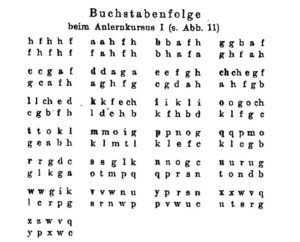The Koch Method is not a sequence of characters but rather it is a method of character introduction that focuses on learning code as acoustic shapes.
Koch began by introducing two well-differentiated sound patterns played randomly without students being told what characters the two sounds corresponded to. Students were asked to mark a sheet of paper by placing a dot each time they heard an acoustic shape. This introduced the student to the rhythm and formed a connection between the acoustically recorded rhythm and the rhythm of the writing hand. Only after the two sound patterns were heard as different and the student had adjusted to the rhythm, were the students told what characters the two sounds corresponded to. After a short period of practice, the relationships between the acoustic impression and the represented characters were firmly established.
Once mastery was achieved to about ninety percent accuracy, the next character was introduced. The new character was played randomly without students being told what character the new sound corresponded to, and students were again asked to mark a sheet of paper by placing a dot each time they heard the new acoustic shape. Character association followed and the three characters were practiced. Koch took special care not to exceed the student’s comprehension range. He did not allow more than three sound patterns to be introduced in the first half-hour of training.
The next three characters were introduced in the same manner. Two sound patterns together followed by a third, but as the number of previously learned characters increased, the two-character process began to overload students. The absorption of new characters and retention of previously learned characters were compromised. The two-character process also took longer practice times to consolidate new characters as compared to introducing characters individually.
Koch also found that once students learned how to learn code as acoustic shapes, it was unnecessary to introduce new characters by playing them without students being told what character the new sound corresponded to.
In summary, playing characters without students being told what characters the sounds correspond to had merit, but the two-character process was ineffective and counterproductive. It took many reads of the study to conclude that Koch was reluctant to admit it. A more casual read of the study would easily lead one to believe the two-character process was the essence of the Koch Method.
The Beginners Carousel curriculum introduces no more than three characters in any lesson, and characters are introduced individually. In BC1 characters are introduced in the Koch Method of playing them without telling students what character the new sound corresponds to. In BC2 characters are introduced in a traditional manner.

